Food Safety: A Case Study on HACCP Plan for Chicken Liver Preparation
VerifiedAdded on 2023/06/03
|10
|2614
|183
Case Study
AI Summary
This case study provides a detailed examination of a food control and Hazard Analysis and Critical Control Points (HACCP) plan for the preparation and serving of chicken liver, a high-risk food due to potential chemical, biological, and physical hazards, particularly Campylobacter contamination. It emphasizes the importance of proper cooking, separation, and sanitation to mitigate risks. The food control plan outlines steps such as sautéing livers in small batches to a minimum temperature of 70 degrees Celsius, using a food thermometer to ensure internal temperatures are reached, and preventing cross-contamination by using separate utensils and boards. The HACCP plan aligns with its seven principles, including hazard analysis, identification of critical control points, and preventative measures like cooking to the required temperature and maintaining clean preparation surfaces. The study also highlights the role of technology in combating Campylobacter infections and underscores the need for high hygiene standards among both consumers and producers of chicken liver.

Running head: FOOD QUALITY 1
Food Control and HACCP plan: Preparing and Serving Chicken Liver
Author
Institution
Food Control and HACCP plan: Preparing and Serving Chicken Liver
Author
Institution
Paraphrase This Document
Need a fresh take? Get an instant paraphrase of this document with our AI Paraphraser
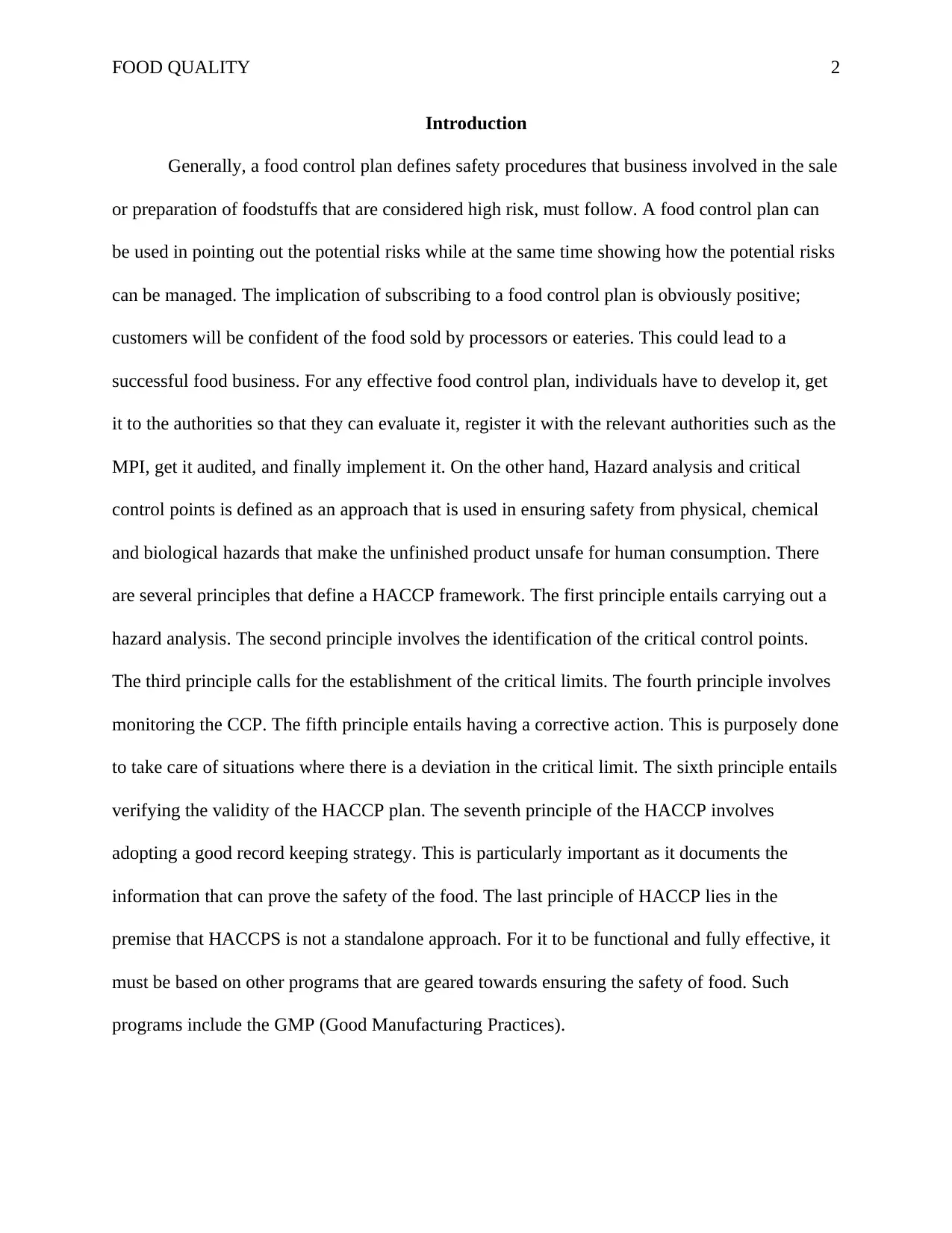
FOOD QUALITY 2
Introduction
Generally, a food control plan defines safety procedures that business involved in the sale
or preparation of foodstuffs that are considered high risk, must follow. A food control plan can
be used in pointing out the potential risks while at the same time showing how the potential risks
can be managed. The implication of subscribing to a food control plan is obviously positive;
customers will be confident of the food sold by processors or eateries. This could lead to a
successful food business. For any effective food control plan, individuals have to develop it, get
it to the authorities so that they can evaluate it, register it with the relevant authorities such as the
MPI, get it audited, and finally implement it. On the other hand, Hazard analysis and critical
control points is defined as an approach that is used in ensuring safety from physical, chemical
and biological hazards that make the unfinished product unsafe for human consumption. There
are several principles that define a HACCP framework. The first principle entails carrying out a
hazard analysis. The second principle involves the identification of the critical control points.
The third principle calls for the establishment of the critical limits. The fourth principle involves
monitoring the CCP. The fifth principle entails having a corrective action. This is purposely done
to take care of situations where there is a deviation in the critical limit. The sixth principle entails
verifying the validity of the HACCP plan. The seventh principle of the HACCP involves
adopting a good record keeping strategy. This is particularly important as it documents the
information that can prove the safety of the food. The last principle of HACCP lies in the
premise that HACCPS is not a standalone approach. For it to be functional and fully effective, it
must be based on other programs that are geared towards ensuring the safety of food. Such
programs include the GMP (Good Manufacturing Practices).
Introduction
Generally, a food control plan defines safety procedures that business involved in the sale
or preparation of foodstuffs that are considered high risk, must follow. A food control plan can
be used in pointing out the potential risks while at the same time showing how the potential risks
can be managed. The implication of subscribing to a food control plan is obviously positive;
customers will be confident of the food sold by processors or eateries. This could lead to a
successful food business. For any effective food control plan, individuals have to develop it, get
it to the authorities so that they can evaluate it, register it with the relevant authorities such as the
MPI, get it audited, and finally implement it. On the other hand, Hazard analysis and critical
control points is defined as an approach that is used in ensuring safety from physical, chemical
and biological hazards that make the unfinished product unsafe for human consumption. There
are several principles that define a HACCP framework. The first principle entails carrying out a
hazard analysis. The second principle involves the identification of the critical control points.
The third principle calls for the establishment of the critical limits. The fourth principle involves
monitoring the CCP. The fifth principle entails having a corrective action. This is purposely done
to take care of situations where there is a deviation in the critical limit. The sixth principle entails
verifying the validity of the HACCP plan. The seventh principle of the HACCP involves
adopting a good record keeping strategy. This is particularly important as it documents the
information that can prove the safety of the food. The last principle of HACCP lies in the
premise that HACCPS is not a standalone approach. For it to be functional and fully effective, it
must be based on other programs that are geared towards ensuring the safety of food. Such
programs include the GMP (Good Manufacturing Practices).

FOOD QUALITY 3
Case Study: Food Control Plan and HACCP plan for Preparing and Serving
Chicken Liver.
Background of the Study
Interestingly, chicken liver is considered to be high risk food subject to chemical,
biological and physical hazards. Unlike other red meat pieces like chops or steak where
microbial happens on the external surfaces only, livers are unique in that they can be
contaminated both on the outer surfaces and the inside tissues (Hutchison, Harrison, Richardson,
& Tchórzewska, 2015). The most contaminant of livers is known as the Campylobacter. Most
importantly, it is critical to note that the level of Campylobacter prevalence in poultry meat is
quite high when compared to other sources of meat proteins such as beef and mutton. Having
identified the source and level of risk in chicken liver, it is appropriate to determine the controls
necessary for bringing down the infection rates by embracing good heating practices that don’t
interfere with the quality of the chicken liver. A number of recent studies that are based on the
subject of quality control and food safety confirm the fact that the preparation and serving of
chicken liver should not be taken on a light note. As a matter of fact, several research studies
have validated the hypothesis that poorly cooked chicken liver constantly exposes individuals
and the public to food poisoning of the Campylobacter. Most of these research studies were
structured in such a way that the number of times for chicken liver was used as a comparison of
the complaints of symptoms that matched the description of those for Campylobacter.
The research studies indicated that amongst a total of 141 chefs that participated in the
study, between 19 and 52 percent of them did not attain the 70 degree temperature mark that is
necessary to kill the Campylobacter pathogen. What is even surprising is the fact that the public
could rarely identify poorly cooked chicken liver (Hutchison, Harrison, Richardson, &
Case Study: Food Control Plan and HACCP plan for Preparing and Serving
Chicken Liver.
Background of the Study
Interestingly, chicken liver is considered to be high risk food subject to chemical,
biological and physical hazards. Unlike other red meat pieces like chops or steak where
microbial happens on the external surfaces only, livers are unique in that they can be
contaminated both on the outer surfaces and the inside tissues (Hutchison, Harrison, Richardson,
& Tchórzewska, 2015). The most contaminant of livers is known as the Campylobacter. Most
importantly, it is critical to note that the level of Campylobacter prevalence in poultry meat is
quite high when compared to other sources of meat proteins such as beef and mutton. Having
identified the source and level of risk in chicken liver, it is appropriate to determine the controls
necessary for bringing down the infection rates by embracing good heating practices that don’t
interfere with the quality of the chicken liver. A number of recent studies that are based on the
subject of quality control and food safety confirm the fact that the preparation and serving of
chicken liver should not be taken on a light note. As a matter of fact, several research studies
have validated the hypothesis that poorly cooked chicken liver constantly exposes individuals
and the public to food poisoning of the Campylobacter. Most of these research studies were
structured in such a way that the number of times for chicken liver was used as a comparison of
the complaints of symptoms that matched the description of those for Campylobacter.
The research studies indicated that amongst a total of 141 chefs that participated in the
study, between 19 and 52 percent of them did not attain the 70 degree temperature mark that is
necessary to kill the Campylobacter pathogen. What is even surprising is the fact that the public
could rarely identify poorly cooked chicken liver (Hutchison, Harrison, Richardson, &
⊘ This is a preview!⊘
Do you want full access?
Subscribe today to unlock all pages.

Trusted by 1+ million students worldwide
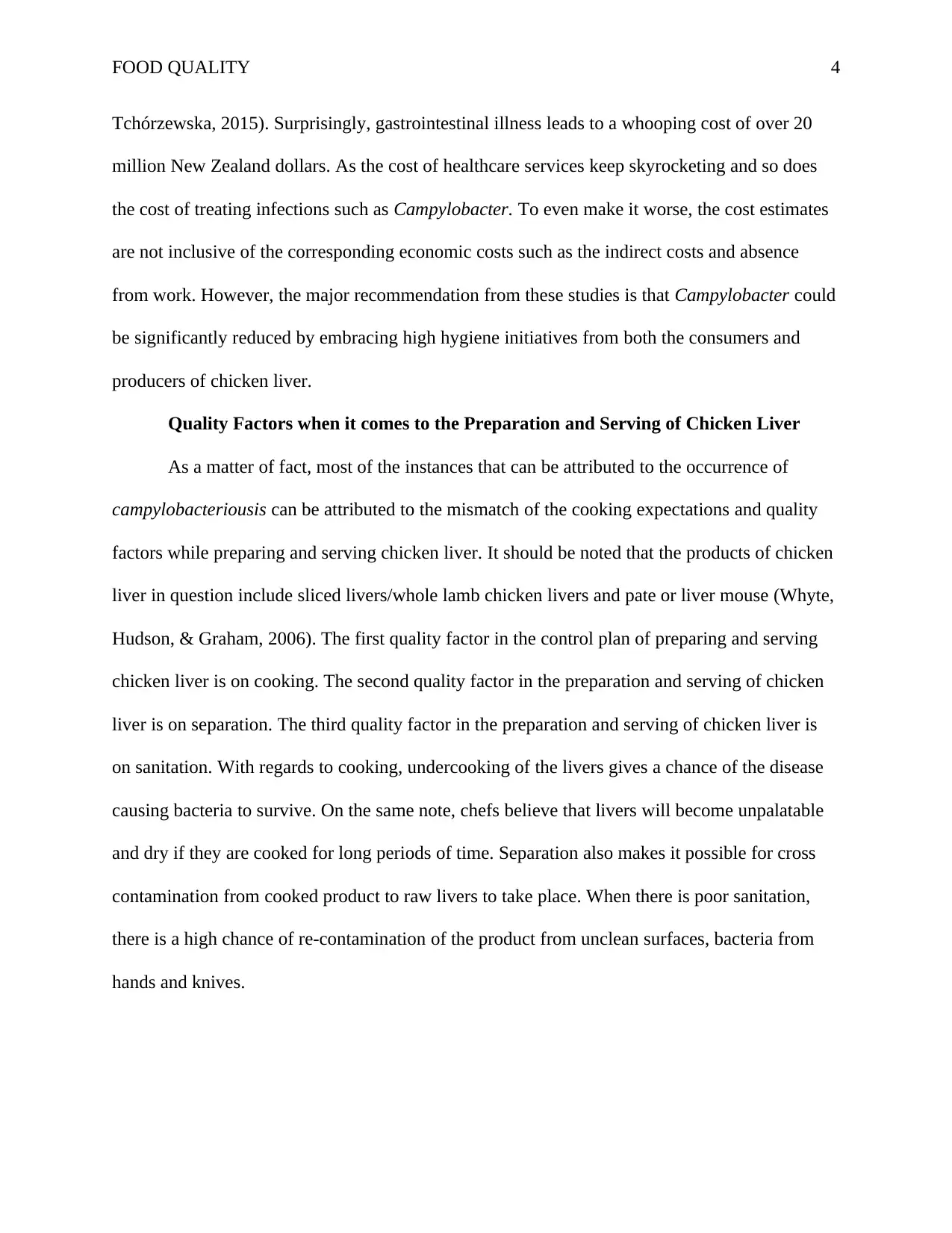
FOOD QUALITY 4
Tchórzewska, 2015). Surprisingly, gastrointestinal illness leads to a whooping cost of over 20
million New Zealand dollars. As the cost of healthcare services keep skyrocketing and so does
the cost of treating infections such as Campylobacter. To even make it worse, the cost estimates
are not inclusive of the corresponding economic costs such as the indirect costs and absence
from work. However, the major recommendation from these studies is that Campylobacter could
be significantly reduced by embracing high hygiene initiatives from both the consumers and
producers of chicken liver.
Quality Factors when it comes to the Preparation and Serving of Chicken Liver
As a matter of fact, most of the instances that can be attributed to the occurrence of
campylobacteriousis can be attributed to the mismatch of the cooking expectations and quality
factors while preparing and serving chicken liver. It should be noted that the products of chicken
liver in question include sliced livers/whole lamb chicken livers and pate or liver mouse (Whyte,
Hudson, & Graham, 2006). The first quality factor in the control plan of preparing and serving
chicken liver is on cooking. The second quality factor in the preparation and serving of chicken
liver is on separation. The third quality factor in the preparation and serving of chicken liver is
on sanitation. With regards to cooking, undercooking of the livers gives a chance of the disease
causing bacteria to survive. On the same note, chefs believe that livers will become unpalatable
and dry if they are cooked for long periods of time. Separation also makes it possible for cross
contamination from cooked product to raw livers to take place. When there is poor sanitation,
there is a high chance of re-contamination of the product from unclean surfaces, bacteria from
hands and knives.
Tchórzewska, 2015). Surprisingly, gastrointestinal illness leads to a whooping cost of over 20
million New Zealand dollars. As the cost of healthcare services keep skyrocketing and so does
the cost of treating infections such as Campylobacter. To even make it worse, the cost estimates
are not inclusive of the corresponding economic costs such as the indirect costs and absence
from work. However, the major recommendation from these studies is that Campylobacter could
be significantly reduced by embracing high hygiene initiatives from both the consumers and
producers of chicken liver.
Quality Factors when it comes to the Preparation and Serving of Chicken Liver
As a matter of fact, most of the instances that can be attributed to the occurrence of
campylobacteriousis can be attributed to the mismatch of the cooking expectations and quality
factors while preparing and serving chicken liver. It should be noted that the products of chicken
liver in question include sliced livers/whole lamb chicken livers and pate or liver mouse (Whyte,
Hudson, & Graham, 2006). The first quality factor in the control plan of preparing and serving
chicken liver is on cooking. The second quality factor in the preparation and serving of chicken
liver is on separation. The third quality factor in the preparation and serving of chicken liver is
on sanitation. With regards to cooking, undercooking of the livers gives a chance of the disease
causing bacteria to survive. On the same note, chefs believe that livers will become unpalatable
and dry if they are cooked for long periods of time. Separation also makes it possible for cross
contamination from cooked product to raw livers to take place. When there is poor sanitation,
there is a high chance of re-contamination of the product from unclean surfaces, bacteria from
hands and knives.
Paraphrase This Document
Need a fresh take? Get an instant paraphrase of this document with our AI Paraphraser
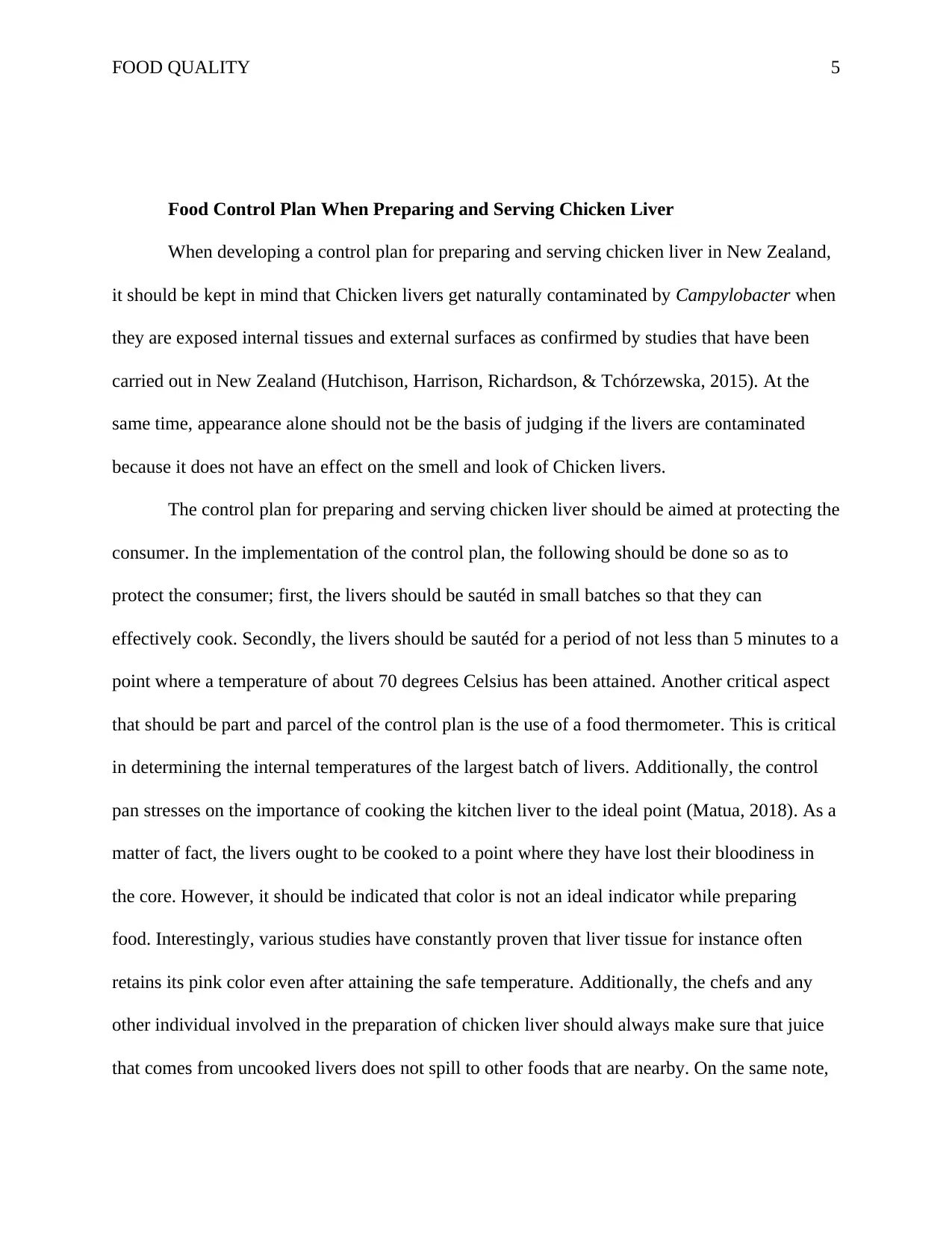
FOOD QUALITY 5
Food Control Plan When Preparing and Serving Chicken Liver
When developing a control plan for preparing and serving chicken liver in New Zealand,
it should be kept in mind that Chicken livers get naturally contaminated by Campylobacter when
they are exposed internal tissues and external surfaces as confirmed by studies that have been
carried out in New Zealand (Hutchison, Harrison, Richardson, & Tchórzewska, 2015). At the
same time, appearance alone should not be the basis of judging if the livers are contaminated
because it does not have an effect on the smell and look of Chicken livers.
The control plan for preparing and serving chicken liver should be aimed at protecting the
consumer. In the implementation of the control plan, the following should be done so as to
protect the consumer; first, the livers should be sautéd in small batches so that they can
effectively cook. Secondly, the livers should be sautéd for a period of not less than 5 minutes to a
point where a temperature of about 70 degrees Celsius has been attained. Another critical aspect
that should be part and parcel of the control plan is the use of a food thermometer. This is critical
in determining the internal temperatures of the largest batch of livers. Additionally, the control
pan stresses on the importance of cooking the kitchen liver to the ideal point (Matua, 2018). As a
matter of fact, the livers ought to be cooked to a point where they have lost their bloodiness in
the core. However, it should be indicated that color is not an ideal indicator while preparing
food. Interestingly, various studies have constantly proven that liver tissue for instance often
retains its pink color even after attaining the safe temperature. Additionally, the chefs and any
other individual involved in the preparation of chicken liver should always make sure that juice
that comes from uncooked livers does not spill to other foods that are nearby. On the same note,
Food Control Plan When Preparing and Serving Chicken Liver
When developing a control plan for preparing and serving chicken liver in New Zealand,
it should be kept in mind that Chicken livers get naturally contaminated by Campylobacter when
they are exposed internal tissues and external surfaces as confirmed by studies that have been
carried out in New Zealand (Hutchison, Harrison, Richardson, & Tchórzewska, 2015). At the
same time, appearance alone should not be the basis of judging if the livers are contaminated
because it does not have an effect on the smell and look of Chicken livers.
The control plan for preparing and serving chicken liver should be aimed at protecting the
consumer. In the implementation of the control plan, the following should be done so as to
protect the consumer; first, the livers should be sautéd in small batches so that they can
effectively cook. Secondly, the livers should be sautéd for a period of not less than 5 minutes to a
point where a temperature of about 70 degrees Celsius has been attained. Another critical aspect
that should be part and parcel of the control plan is the use of a food thermometer. This is critical
in determining the internal temperatures of the largest batch of livers. Additionally, the control
pan stresses on the importance of cooking the kitchen liver to the ideal point (Matua, 2018). As a
matter of fact, the livers ought to be cooked to a point where they have lost their bloodiness in
the core. However, it should be indicated that color is not an ideal indicator while preparing
food. Interestingly, various studies have constantly proven that liver tissue for instance often
retains its pink color even after attaining the safe temperature. Additionally, the chefs and any
other individual involved in the preparation of chicken liver should always make sure that juice
that comes from uncooked livers does not spill to other foods that are nearby. On the same note,
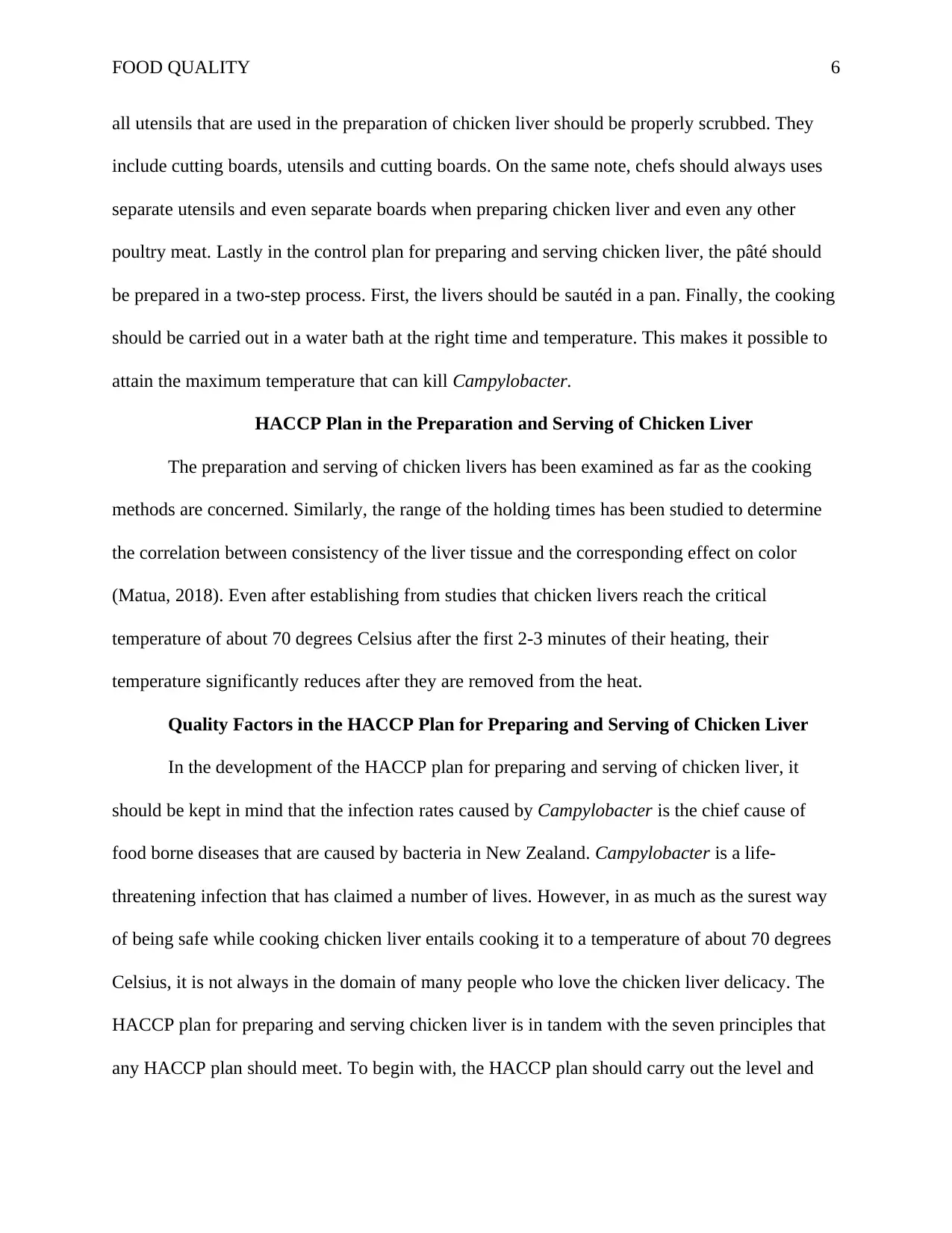
FOOD QUALITY 6
all utensils that are used in the preparation of chicken liver should be properly scrubbed. They
include cutting boards, utensils and cutting boards. On the same note, chefs should always uses
separate utensils and even separate boards when preparing chicken liver and even any other
poultry meat. Lastly in the control plan for preparing and serving chicken liver, the pâté should
be prepared in a two-step process. First, the livers should be sautéd in a pan. Finally, the cooking
should be carried out in a water bath at the right time and temperature. This makes it possible to
attain the maximum temperature that can kill Campylobacter.
HACCP Plan in the Preparation and Serving of Chicken Liver
The preparation and serving of chicken livers has been examined as far as the cooking
methods are concerned. Similarly, the range of the holding times has been studied to determine
the correlation between consistency of the liver tissue and the corresponding effect on color
(Matua, 2018). Even after establishing from studies that chicken livers reach the critical
temperature of about 70 degrees Celsius after the first 2-3 minutes of their heating, their
temperature significantly reduces after they are removed from the heat.
Quality Factors in the HACCP Plan for Preparing and Serving of Chicken Liver
In the development of the HACCP plan for preparing and serving of chicken liver, it
should be kept in mind that the infection rates caused by Campylobacter is the chief cause of
food borne diseases that are caused by bacteria in New Zealand. Campylobacter is a life-
threatening infection that has claimed a number of lives. However, in as much as the surest way
of being safe while cooking chicken liver entails cooking it to a temperature of about 70 degrees
Celsius, it is not always in the domain of many people who love the chicken liver delicacy. The
HACCP plan for preparing and serving chicken liver is in tandem with the seven principles that
any HACCP plan should meet. To begin with, the HACCP plan should carry out the level and
all utensils that are used in the preparation of chicken liver should be properly scrubbed. They
include cutting boards, utensils and cutting boards. On the same note, chefs should always uses
separate utensils and even separate boards when preparing chicken liver and even any other
poultry meat. Lastly in the control plan for preparing and serving chicken liver, the pâté should
be prepared in a two-step process. First, the livers should be sautéd in a pan. Finally, the cooking
should be carried out in a water bath at the right time and temperature. This makes it possible to
attain the maximum temperature that can kill Campylobacter.
HACCP Plan in the Preparation and Serving of Chicken Liver
The preparation and serving of chicken livers has been examined as far as the cooking
methods are concerned. Similarly, the range of the holding times has been studied to determine
the correlation between consistency of the liver tissue and the corresponding effect on color
(Matua, 2018). Even after establishing from studies that chicken livers reach the critical
temperature of about 70 degrees Celsius after the first 2-3 minutes of their heating, their
temperature significantly reduces after they are removed from the heat.
Quality Factors in the HACCP Plan for Preparing and Serving of Chicken Liver
In the development of the HACCP plan for preparing and serving of chicken liver, it
should be kept in mind that the infection rates caused by Campylobacter is the chief cause of
food borne diseases that are caused by bacteria in New Zealand. Campylobacter is a life-
threatening infection that has claimed a number of lives. However, in as much as the surest way
of being safe while cooking chicken liver entails cooking it to a temperature of about 70 degrees
Celsius, it is not always in the domain of many people who love the chicken liver delicacy. The
HACCP plan for preparing and serving chicken liver is in tandem with the seven principles that
any HACCP plan should meet. To begin with, the HACCP plan should carry out the level and
⊘ This is a preview!⊘
Do you want full access?
Subscribe today to unlock all pages.

Trusted by 1+ million students worldwide
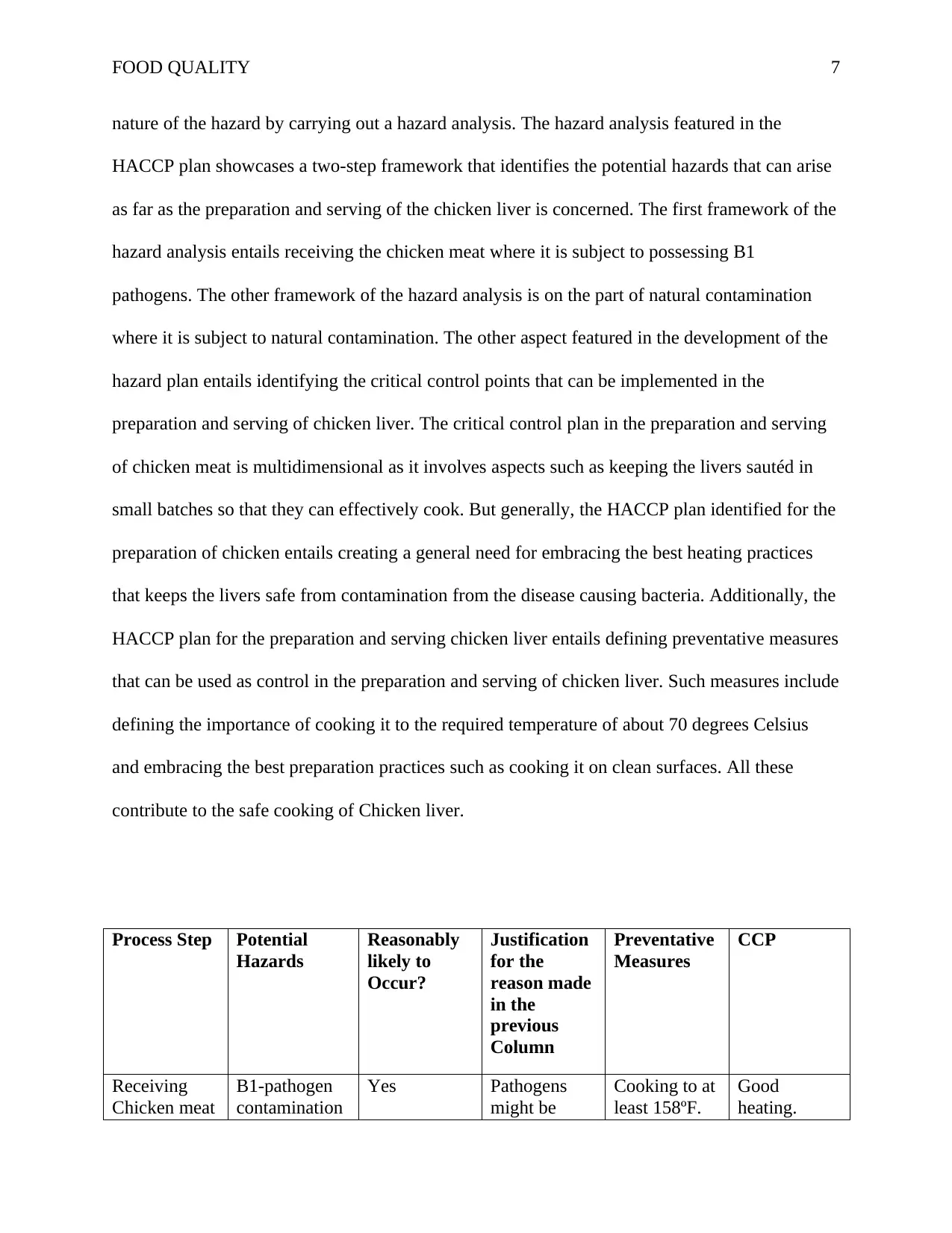
FOOD QUALITY 7
nature of the hazard by carrying out a hazard analysis. The hazard analysis featured in the
HACCP plan showcases a two-step framework that identifies the potential hazards that can arise
as far as the preparation and serving of the chicken liver is concerned. The first framework of the
hazard analysis entails receiving the chicken meat where it is subject to possessing B1
pathogens. The other framework of the hazard analysis is on the part of natural contamination
where it is subject to natural contamination. The other aspect featured in the development of the
hazard plan entails identifying the critical control points that can be implemented in the
preparation and serving of chicken liver. The critical control plan in the preparation and serving
of chicken meat is multidimensional as it involves aspects such as keeping the livers sautéd in
small batches so that they can effectively cook. But generally, the HACCP plan identified for the
preparation of chicken entails creating a general need for embracing the best heating practices
that keeps the livers safe from contamination from the disease causing bacteria. Additionally, the
HACCP plan for the preparation and serving chicken liver entails defining preventative measures
that can be used as control in the preparation and serving of chicken liver. Such measures include
defining the importance of cooking it to the required temperature of about 70 degrees Celsius
and embracing the best preparation practices such as cooking it on clean surfaces. All these
contribute to the safe cooking of Chicken liver.
Process Step Potential
Hazards
Reasonably
likely to
Occur?
Justification
for the
reason made
in the
previous
Column
Preventative
Measures
CCP
Receiving
Chicken meat
B1-pathogen
contamination
Yes Pathogens
might be
Cooking to at
least 158ºF.
Good
heating.
nature of the hazard by carrying out a hazard analysis. The hazard analysis featured in the
HACCP plan showcases a two-step framework that identifies the potential hazards that can arise
as far as the preparation and serving of the chicken liver is concerned. The first framework of the
hazard analysis entails receiving the chicken meat where it is subject to possessing B1
pathogens. The other framework of the hazard analysis is on the part of natural contamination
where it is subject to natural contamination. The other aspect featured in the development of the
hazard plan entails identifying the critical control points that can be implemented in the
preparation and serving of chicken liver. The critical control plan in the preparation and serving
of chicken meat is multidimensional as it involves aspects such as keeping the livers sautéd in
small batches so that they can effectively cook. But generally, the HACCP plan identified for the
preparation of chicken entails creating a general need for embracing the best heating practices
that keeps the livers safe from contamination from the disease causing bacteria. Additionally, the
HACCP plan for the preparation and serving chicken liver entails defining preventative measures
that can be used as control in the preparation and serving of chicken liver. Such measures include
defining the importance of cooking it to the required temperature of about 70 degrees Celsius
and embracing the best preparation practices such as cooking it on clean surfaces. All these
contribute to the safe cooking of Chicken liver.
Process Step Potential
Hazards
Reasonably
likely to
Occur?
Justification
for the
reason made
in the
previous
Column
Preventative
Measures
CCP
Receiving
Chicken meat
B1-pathogen
contamination
Yes Pathogens
might be
Cooking to at
least 158ºF.
Good
heating.
Paraphrase This Document
Need a fresh take? Get an instant paraphrase of this document with our AI Paraphraser
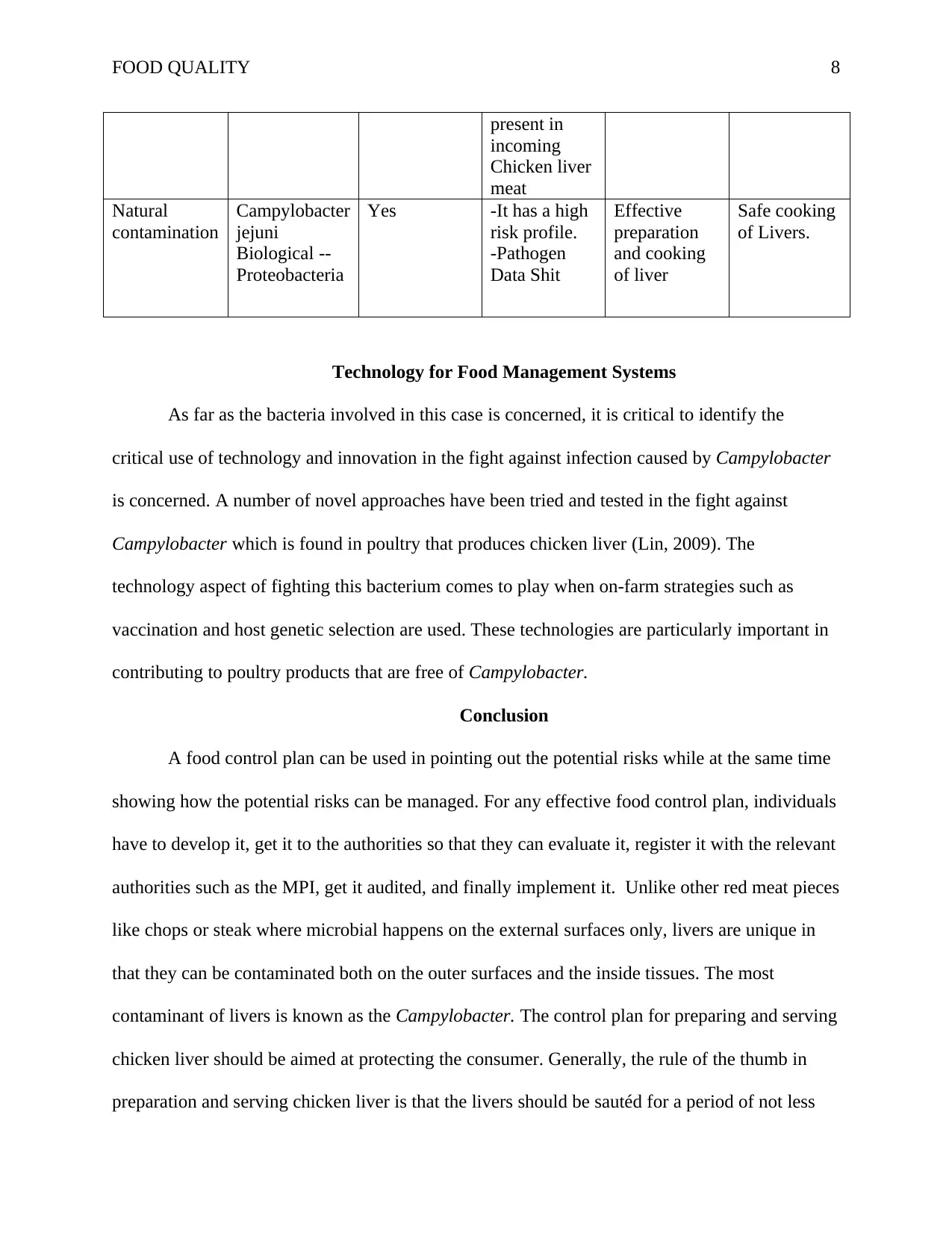
FOOD QUALITY 8
present in
incoming
Chicken liver
meat
Natural
contamination
Campylobacter
jejuni
Biological --
Proteobacteria
Yes -It has a high
risk profile.
-Pathogen
Data Shit
Effective
preparation
and cooking
of liver
Safe cooking
of Livers.
Technology for Food Management Systems
As far as the bacteria involved in this case is concerned, it is critical to identify the
critical use of technology and innovation in the fight against infection caused by Campylobacter
is concerned. A number of novel approaches have been tried and tested in the fight against
Campylobacter which is found in poultry that produces chicken liver (Lin, 2009). The
technology aspect of fighting this bacterium comes to play when on-farm strategies such as
vaccination and host genetic selection are used. These technologies are particularly important in
contributing to poultry products that are free of Campylobacter.
Conclusion
A food control plan can be used in pointing out the potential risks while at the same time
showing how the potential risks can be managed. For any effective food control plan, individuals
have to develop it, get it to the authorities so that they can evaluate it, register it with the relevant
authorities such as the MPI, get it audited, and finally implement it. Unlike other red meat pieces
like chops or steak where microbial happens on the external surfaces only, livers are unique in
that they can be contaminated both on the outer surfaces and the inside tissues. The most
contaminant of livers is known as the Campylobacter. The control plan for preparing and serving
chicken liver should be aimed at protecting the consumer. Generally, the rule of the thumb in
preparation and serving chicken liver is that the livers should be sautéd for a period of not less
present in
incoming
Chicken liver
meat
Natural
contamination
Campylobacter
jejuni
Biological --
Proteobacteria
Yes -It has a high
risk profile.
-Pathogen
Data Shit
Effective
preparation
and cooking
of liver
Safe cooking
of Livers.
Technology for Food Management Systems
As far as the bacteria involved in this case is concerned, it is critical to identify the
critical use of technology and innovation in the fight against infection caused by Campylobacter
is concerned. A number of novel approaches have been tried and tested in the fight against
Campylobacter which is found in poultry that produces chicken liver (Lin, 2009). The
technology aspect of fighting this bacterium comes to play when on-farm strategies such as
vaccination and host genetic selection are used. These technologies are particularly important in
contributing to poultry products that are free of Campylobacter.
Conclusion
A food control plan can be used in pointing out the potential risks while at the same time
showing how the potential risks can be managed. For any effective food control plan, individuals
have to develop it, get it to the authorities so that they can evaluate it, register it with the relevant
authorities such as the MPI, get it audited, and finally implement it. Unlike other red meat pieces
like chops or steak where microbial happens on the external surfaces only, livers are unique in
that they can be contaminated both on the outer surfaces and the inside tissues. The most
contaminant of livers is known as the Campylobacter. The control plan for preparing and serving
chicken liver should be aimed at protecting the consumer. Generally, the rule of the thumb in
preparation and serving chicken liver is that the livers should be sautéd for a period of not less

FOOD QUALITY 9
than 5 minutes to a point where a temperature of about 70 degrees Celsius has been attained. The
HACCP plan for preparing and serving chicken liver is in tandem with the seven principles that
any HACCP plan should meet.
References
than 5 minutes to a point where a temperature of about 70 degrees Celsius has been attained. The
HACCP plan for preparing and serving chicken liver is in tandem with the seven principles that
any HACCP plan should meet.
References
⊘ This is a preview!⊘
Do you want full access?
Subscribe today to unlock all pages.

Trusted by 1+ million students worldwide
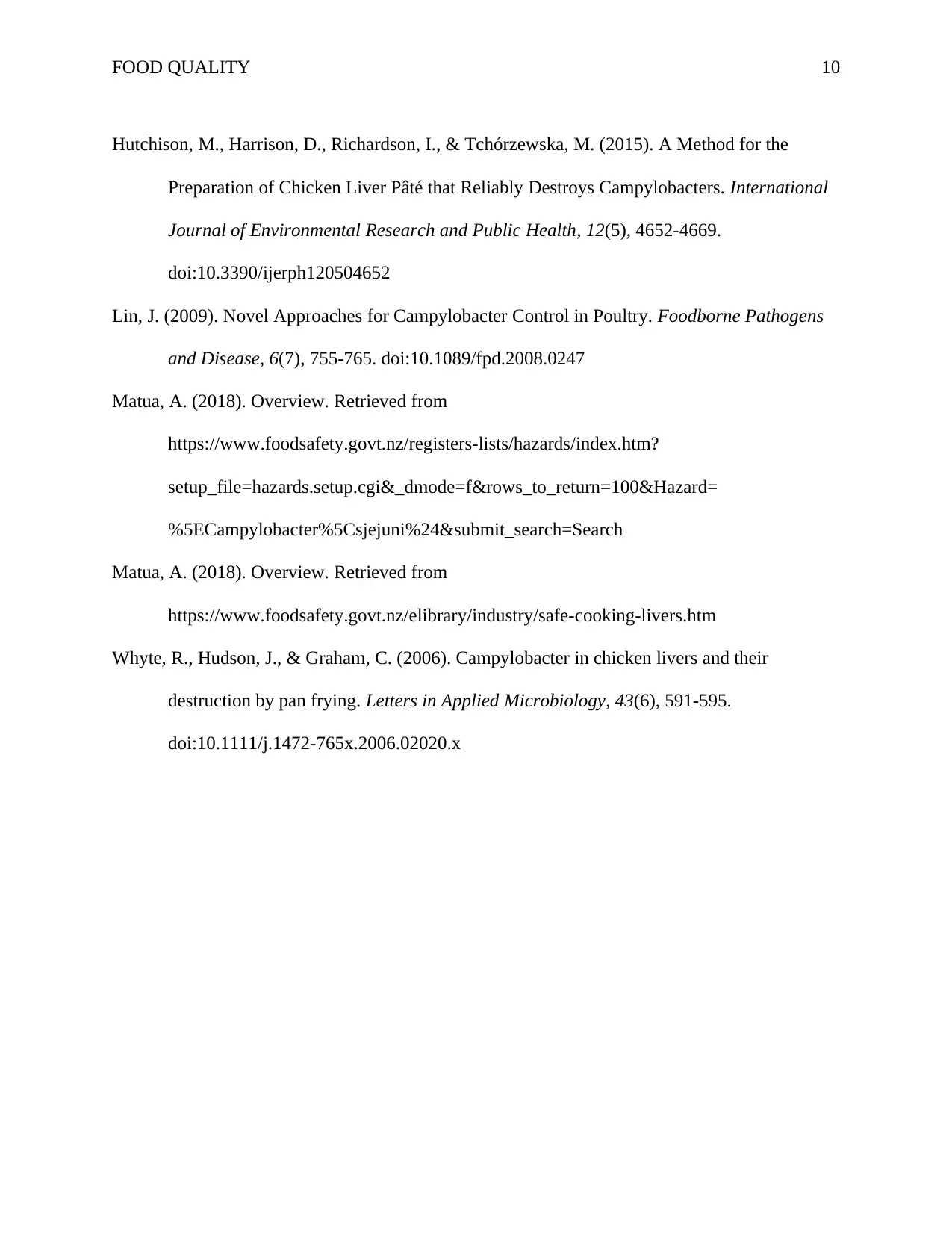
FOOD QUALITY 10
Hutchison, M., Harrison, D., Richardson, I., & Tchórzewska, M. (2015). A Method for the
Preparation of Chicken Liver Pâté that Reliably Destroys Campylobacters. International
Journal of Environmental Research and Public Health, 12(5), 4652-4669.
doi:10.3390/ijerph120504652
Lin, J. (2009). Novel Approaches for Campylobacter Control in Poultry. Foodborne Pathogens
and Disease, 6(7), 755-765. doi:10.1089/fpd.2008.0247
Matua, A. (2018). Overview. Retrieved from
https://www.foodsafety.govt.nz/registers-lists/hazards/index.htm?
setup_file=hazards.setup.cgi&_dmode=f&rows_to_return=100&Hazard=
%5ECampylobacter%5Csjejuni%24&submit_search=Search
Matua, A. (2018). Overview. Retrieved from
https://www.foodsafety.govt.nz/elibrary/industry/safe-cooking-livers.htm
Whyte, R., Hudson, J., & Graham, C. (2006). Campylobacter in chicken livers and their
destruction by pan frying. Letters in Applied Microbiology, 43(6), 591-595.
doi:10.1111/j.1472-765x.2006.02020.x
Hutchison, M., Harrison, D., Richardson, I., & Tchórzewska, M. (2015). A Method for the
Preparation of Chicken Liver Pâté that Reliably Destroys Campylobacters. International
Journal of Environmental Research and Public Health, 12(5), 4652-4669.
doi:10.3390/ijerph120504652
Lin, J. (2009). Novel Approaches for Campylobacter Control in Poultry. Foodborne Pathogens
and Disease, 6(7), 755-765. doi:10.1089/fpd.2008.0247
Matua, A. (2018). Overview. Retrieved from
https://www.foodsafety.govt.nz/registers-lists/hazards/index.htm?
setup_file=hazards.setup.cgi&_dmode=f&rows_to_return=100&Hazard=
%5ECampylobacter%5Csjejuni%24&submit_search=Search
Matua, A. (2018). Overview. Retrieved from
https://www.foodsafety.govt.nz/elibrary/industry/safe-cooking-livers.htm
Whyte, R., Hudson, J., & Graham, C. (2006). Campylobacter in chicken livers and their
destruction by pan frying. Letters in Applied Microbiology, 43(6), 591-595.
doi:10.1111/j.1472-765x.2006.02020.x
1 out of 10
Related Documents
Your All-in-One AI-Powered Toolkit for Academic Success.
+13062052269
info@desklib.com
Available 24*7 on WhatsApp / Email
![[object Object]](/_next/static/media/star-bottom.7253800d.svg)
Unlock your academic potential
Copyright © 2020–2025 A2Z Services. All Rights Reserved. Developed and managed by ZUCOL.





